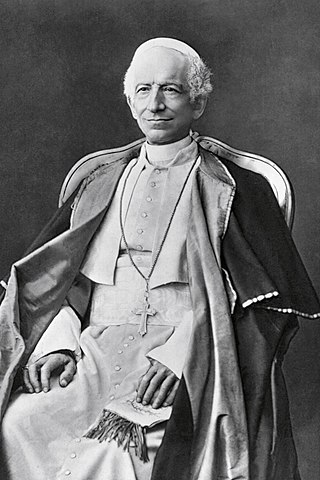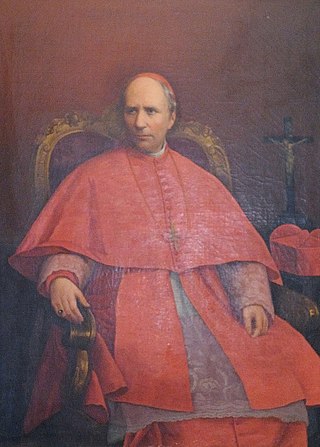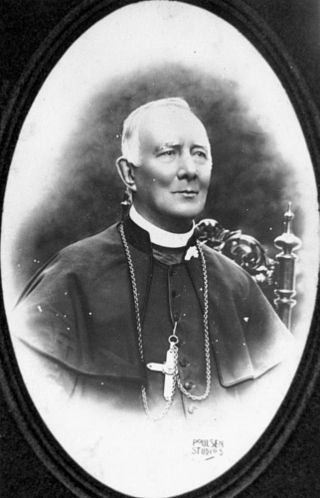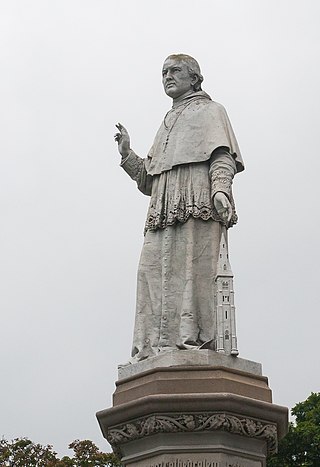Related Research Articles

Traditionalist Catholicism is a movement that emphasizes beliefs, practices, customs, traditions, liturgical forms, devotions and presentations of teaching associated with the Catholic Church before the Second Vatican Council (1962–1965). Traditionalist Catholics particularly emphasize the Tridentine Mass, the Roman Rite liturgy largely replaced in general use by the post-Second Vatican Council Mass of Paul VI.
The Primacy of Ireland belongs to the diocesan bishop of the Irish diocese with highest precedence. The Archbishop of Armagh is titled Primate of All Ireland and the Archbishop of Dublin Primate of Ireland, signifying that they are the senior clerics on the island of Ireland, the Primate of All Ireland being the more senior. The titles are used by both the Catholic Church in Ireland and Church of Ireland. Primate is a title of honour, and in the Middle Ages there was an intense rivalry between Armagh and Dublin as to seniority. The Archbishop of Armagh's leading status is based on the belief that his see was founded by St. Patrick, making Armagh the ecclesiastical capital of Ireland. On the other hand, Dublin is the political, cultural, social, economic and secular centre of Ireland, and has been for many centuries, thus making the Archbishop of Dublin someone of considerable influence, with a high national profile. The dispute between the two archbishoprics was settled by Pope Innocent VI in 1353, with occasional brief controversy since. The distinction mirrors that in the Church of England between the Primate of All England, the Archbishop of Canterbury, and the Primate of England, the Archbishop of York.
The relations between the Catholic Church and the state have been constantly evolving with various forms of government, some of them controversial in retrospect. In its history, the Church has had to deal with various concepts and systems of governance, from the Roman Empire to the medieval divine right of kings, from nineteenth- and twentieth-century concepts of democracy and pluralism to the appearance of left-wing and right-wing dictatorial regimes. The Second Vatican Council's decree Dignitatis humanae stated that religious freedom is a civil right that should be recognized in constitutional law.

Thomas William Croke D.D. was the second Catholic Bishop of Auckland, New Zealand (1870–74) and later Archbishop of Cashel and Emly in Ireland. He was important in the Irish nationalist movement, especially as a Champion of the Irish National Land League in the 1880s. The main Gaelic Athletic Association stadium in Dublin is named Croke Park, in his honour.

The papal conclave held from 18 to 20 February 1878 saw the election of Vincenzo Pecci, who took the name Leo XIII as pope. Held after the death of Pius IX, who had had the longest pontificate since Saint Peter, it was the first election of a pope who would not rule the Papal States. It was the first to meet in the Apostolic Palace in the Vatican because the venue used earlier in the 19th century, the Quirinal Palace, was now the palace of the king of Italy, Umberto I.

Paul Cardinal Cullen was Roman Catholic Archbishop of Dublin and previously of Armagh, and the first Irish cardinal. His Ultramontanism spearheaded the Romanisation of the Catholic Church in Ireland and ushered in the devotional revolution experienced in Ireland through the second half of the 19th century and much of the 20th century. A trained biblical theologian and scholar of ancient languages, Cullen crafted the formula for papal infallibility at the First Vatican Council.

Seán Cardinal Brady KGCHS is a senior-ranking Irish Catholic prelate. He was Primate of All Ireland and Archbishop of Armagh from 1996 until 2014, and was elevated to the rank of cardinal by Pope Benedict XVI in 2007. He left office in 2014 and was succeeded by Eamon Martin, who had served as Coadjutor Archbishop of Armagh since 2013.
The Catholic Church in Ireland, or Irish Catholic Church, is part of the worldwide Catholic Church in communion with the Holy See. With 3.5 million members, it is the largest Christian church in Ireland. In the Republic of Ireland's 2022 census, 69% of the population identified as Roman Catholic. By contrast, 41% of people in Northern Ireland identified as Catholic at the 2011 census; it is expected that this proportion will increase in the coming years. The Archbishop of Armagh, as the Primate of All Ireland, has ceremonial precedence in the church. The church is administered on an all-Ireland basis. The Irish Catholic Bishops' Conference is a consultative body for ordinaries in Ireland.

Joseph Cardinal MacRory was an Irish Cardinal of the Roman Catholic Church who served as Archbishop of Armagh from 1928 until his death. He was elevated to the cardinalate in 1929. He is regarded as the leading Catholic churchman in Ireland during the period spanning the 1916 Rising, Partition, and the Second World War.
William Crolly was the Bishop of Down and Connor from 1825 to 1835, and the Roman Catholic Archbishop of Armagh from 1835 to 1849.

The Catholic Church in England and Wales is part of the worldwide Catholic Church in full communion with the Holy See. Its origins date from the 6th century, when Pope Gregory I through a Roman missionary and Benedictine monk, Augustine, later Augustine of Canterbury, intensified the evangelization of the Kingdom of Kent, linking it to the Holy See in 597 AD.

Edward Cardinal MacCabe or McCabe was the Roman Catholic Archbishop of Dublin from 1879 until his death and a Cardinal from 1882.

Patrick Francis Moran was a prelate of the Catholic Church and the third Archbishop of Sydney and the first cardinal appointed from Australia.

Roger William Bede Vaughan O.S.B. was an English Benedictine monk of Downside Abbey and the second Roman Catholic Archbishop of Sydney, Australia, from 1877 to 1883.
The Archbishop of Dublin is the head of the Archdiocese of Dublin in the Catholic Church, responsible for its spiritual and administrative needs. The office has existed since 1152, in succession to a regular bishopric since 1028. The archdiocese is the metropolitan see of the ecclesiastical province of Dublin, and the archbishop is also styled the Primate of Ireland. The cathedral church of the archdiocese is Saint Mary's Pro-Cathedral in Dublin city, although the Church formally claims Christ Church as its cathedral, and the archbishop's residence is Archbishop's House in Drumcondra.

Daniel McGettigan (1815–1887) was an Irish prelate of the Roman Catholic Church. He served Bishop of Raphoe from 1861 to 1870 and Archbishop of Armagh from 1870 to 1887.

Holy Cross College, located on Clonliffe Road, Drumcondra, was founded in 1854 as the Catholic diocesan seminary for Dublin by Paul Cullen, Archbishop of Dublin (later created, in 1866.

The Archbishop of Dublin is an archiepiscopal title which takes its name from Dublin, Ireland. Since the Reformation, there have been parallel apostolic successions to the title: one in the Catholic Church and the other in the Church of Ireland. The archbishop of each denomination also holds the title of Primate of Ireland.
George Joseph Plunket Browne (1795–1858) was an Irish Roman Catholic clergyman. Born to a "well-known Roscommon family", he served as Bishop of Galway from 1831 until 1844, and afterward as Bishop of Elphin, until his death on 1 December 1858. He was charged with being a "Cullenite" in 1855, that is, a follower of ultramontane Paul Cardinal Cullen.
The Right Reverend James Murray D.D. was a Roman Catholic bishop, the first resident Bishop of the diocese of Maitland in New South Wales, Australia.
References
- ↑ Griggs, Barbara; Zee, Barbara Van der (1997). Green Pharmacy: The History and Evolution of Western Herbal Medicine. Inner Traditions/Bear. p. 141. ISBN 9780892817276.
- ↑ Bowen, Desmond (1983). Paul Cardinal Cullen and the Shaping of Modern Irish Catholicism . Wilfrid Laurier UP. p. 253. ISBN 9780889201361.
- ↑ Buckley, James; Bauerschmidt, Frederick Christian; Pomplun, Trent (2010). The Blackwell Companion to Catholicism. John Wiley & Sons. p. 223. ISBN 9781444337327.
- ↑ Akenson, Donald Harman (2011). Ireland, Sweden, and the Great European Migration, 1815–1914. MQUP. p. 211. ISBN 9780773539570.